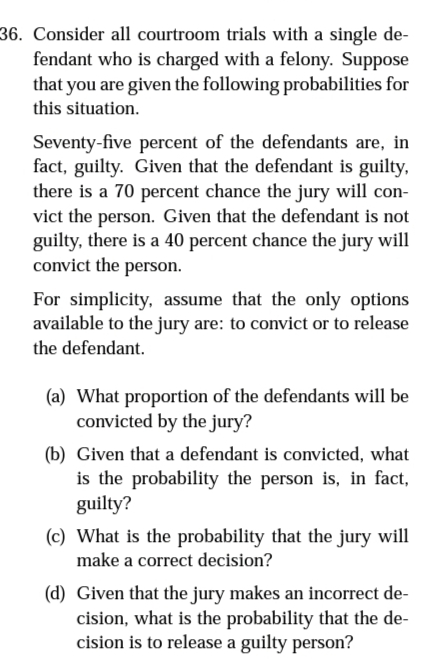36. Consider all courtroom trials with a single de- fendant who is charged with a felony. Suppose that you are given the following probabilities for this situation. Seventy-five percent of the defendants are, in fact, guilty. Given that the defendant is guilty, there is a 70 percent chance the jury will con- vict the person. Given that the defendant is not guilty, there is a 40 percent chance the jury will convict the person. For simplicity, assume that the only options available to the jury are: to convict or to release the defendant. (a) What proportion of the defendants will be convicted by the jury? (b) Given that a defendant is convicted, what is the probability the person is, in fact, guilty? (c) What is the probability that the jury will make a correct decision?
36. Consider all courtroom trials with a single de- fendant who is charged with a felony. Suppose that you are given the following probabilities for this situation. Seventy-five percent of the defendants are, in fact, guilty. Given that the defendant is guilty, there is a 70 percent chance the jury will con- vict the person. Given that the defendant is not guilty, there is a 40 percent chance the jury will convict the person. For simplicity, assume that the only options available to the jury are: to convict or to release the defendant. (a) What proportion of the defendants will be convicted by the jury? (b) Given that a defendant is convicted, what is the probability the person is, in fact, guilty? (c) What is the probability that the jury will make a correct decision?
Holt Mcdougal Larson Pre-algebra: Student Edition 2012
1st Edition
ISBN:9780547587776
Author:HOLT MCDOUGAL
Publisher:HOLT MCDOUGAL
Chapter11: Data Analysis And Probability
Section11.8: Probabilities Of Disjoint And Overlapping Events
Problem 2C
Related questions
Question
100%

Transcribed Image Text:36. Consider all courtroom trials with a single de-
fendant who is charged with a felony. Suppose
that you are given the following probabilities for
this situation.
Seventy-five percent of the defendants are, in
fact, guilty. Given that the defendant is guilty,
there is a 70 percent chance the jury will con-
vict the person. Given that the defendant is not
guilty, there is a 40 percent chance the jury will
convict the person.
For simplicity, assume that the only options
available to the jury are: to convict or to release
the defendant.
(a) What proportion of the defendants will be
convicted by the jury?
(b) Given that a defendant is convicted, what
is the probability the person is, in fact,
guilty?
(c) What is the probability that the jury will
make a correct decision?
(d) Given that the jury makes an incorrect de-
cision, what is the probability that the de-
cision is to release a guilty person?
Expert Solution
This question has been solved!
Explore an expertly crafted, step-by-step solution for a thorough understanding of key concepts.
Step by step
Solved in 3 steps with 3 images

Recommended textbooks for you

Holt Mcdougal Larson Pre-algebra: Student Edition…
Algebra
ISBN:
9780547587776
Author:
HOLT MCDOUGAL
Publisher:
HOLT MCDOUGAL

Holt Mcdougal Larson Pre-algebra: Student Edition…
Algebra
ISBN:
9780547587776
Author:
HOLT MCDOUGAL
Publisher:
HOLT MCDOUGAL